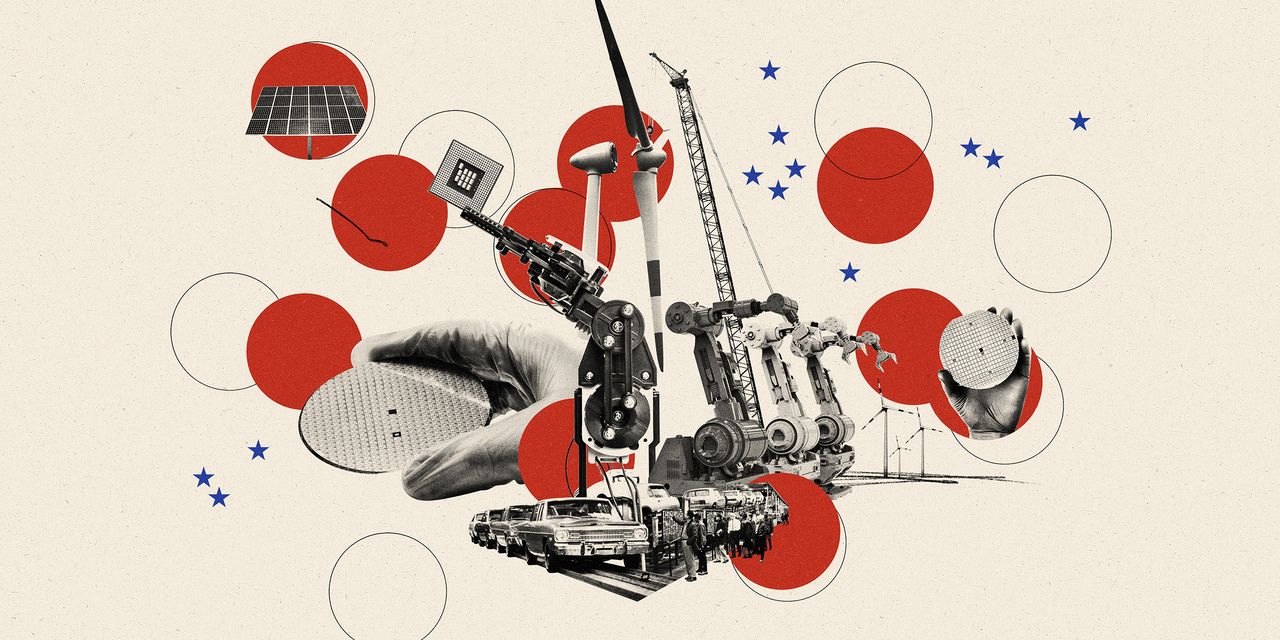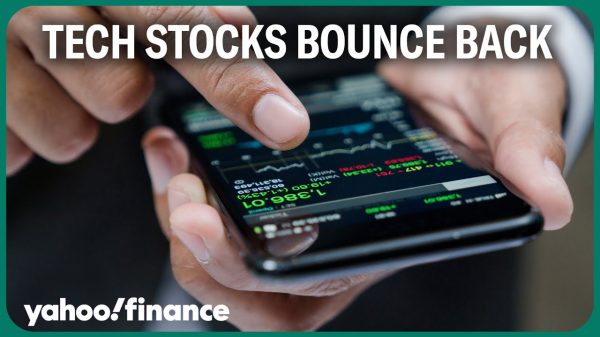The U.S. has embarked on its most aggressive industrial policy since the Cold War as it grapples with the twin threats of a rising China and climate change. The pivot has accelerated a manufacturing revival and spurred investment that will reshape key parts of the economy. But it comes at a cost, threatening to keep inflation higher as the nation makes more goods and imports less.
Industrial policy—loosely defined as government support for strategic industries through tools such as tax credits, subsidies, and tariffs—has been out of favor since the 1980s, under the assumption that free markets work best. Indeed, the U.S. has spent much of the past decade taking China to task for a heavy-handed role in its economy.
But the shortages created by the pandemic, increased competition from a newly aggressive China, and weather disasters that put a focus on climate change have forced a rethink of the nation’s role in the economy. That has paved the way for almost $2.4 trillion in U.S. funding over the next decade through a trio of bills: the Creating Helpful Incentives to Produce Semiconductors and Science (Chips) Act, aimed at re-energizing the domestic semiconductor industry; the Infrastructure Investment and Jobs (IIJ) Act; and the Inflation Reduction Act (IRA), which includes subsidies for clean energy and measures to spur innovation aimed at lowering emissions.
The U.S. is no stranger to industrial policy. Alexander Hamilton favored tariffs and subsidies to diversify the economy beyond its agrarian roots. More recently, investments into the Defense Advanced Research Projects Agency, or Darpa, helped birth the internet—and the companies that sprung up as a result. The agricultural sector has long had government support, and the U.S. has stepped in to help stabilize banks, most recently in this past spring’s efforts to rescue regional banks.
For the Biden administration, industrial policy is a way to make U.S. companies more competitive and less reliant on far-flung supply chains. “We are having a sea change in how we think about the role of government and the economy, its tools and purposes—a spectrum shift in both parties,” says Scott Kennedy, a China economy expert at the Center for Strategic and International Studies think tank. “There’s a growing view that because [China has] stepped on the scales and changed the game, we have no choice but to step in.”
The shift brings opportunities for investors as these policies supercharge a manufacturing renaissance and create innovation hubs. As the IRA and Chips Act hit their first anniversary this summer, investors see some of the biggest opportunities in renewable energy and electric vehicles; industrial firms like
Eaton
(ticker: ETN),
Siemens
(SIEGY), and
Emerson Electric
(EMR) could benefit from the energy transition or the need to automate as companies move production away from the lowest-cost spots. Companies needed to build out infrastructure and new plants, and companies like aggregate-materials maker
CRH
(CRH) also stand to benefit.
“We hope we end up with more resilience, but it’s a less efficient world, probably with more inflation, higher costs, and more supply-side constraints because of the fragmentation in global supply chains,” says Michael Spence, a senior fellow at the Hoover Institution and professor of economics at New York University.
Mark Zandi, chief economist at Moody’s Analytics, says globalization shaved O.1% off yearly inflation in the 20 years before the Trump administration’s 2018 tariffs, as manufacturers took advantage of lower costs in China and elsewhere. As production moves to higher-cost areas such as the U.S., he says annual inflation could be boosted by 0.1% to 0.3%.
Goldman Sachs has put a $1.2 trillion price tag on the climate legislation alone. Still, economists in a paper from the Brookings Institution this past spring stressed that the cost depends on factors including how the private sector responds to tax credits for clean-electricity generation and storage, the price of solar panels and wind turbines, and even whether companies can get factories permitted and connected to the electricity grid.
Economists don’t see the U.S. headed down the path of the more heavy-handed industry policy used in Europe or China. Relative to its economy, China spends on industrial policy about 10 to 20 times that of the U.S. government.
Investment is already pouring into the U.S. from domestic and foreign companies. For example a group of auto makers—including
General Motors
(GM),
Honda Motor
(HMC),
Hyundai Motor
(5380.South Korea),
BMW Group
(BMWYY), and
Stellantis
(STLA)—are investing $1 billion through a joint venture to build charging ports across the country, while
Ford Motor
(F) has partnered with battery maker SK On to build three battery plants in the South. About 270 new projects have been announced, amounting to roughly $130 billion in investment and creating about 90,000 jobs. Many are in red states, giving economists confidence that even a return to Republican rule won’t lead to a wholesale reversal of the trend.
Strategists see more industrial spending ahead as companies capitalize on climate legislation and declining renewable-energy costs. Making supply chains more resilient and bringing production closer to home has been a popular topic on recent company calls with investors. Capital spending rose for the ninth straight quarter in this year’s second quarter. “The investment has skyrocketed and is still unraveling,” says Dimple Gosai, head of U.S. ESG strategy at Bank of America.
Manufacturing shrank as globalization gained sway, with the U.S. losing 5.7 million factory jobs from 2000 to 2010. Now, as industrial policies add to a revitalization of manufacturing, goods could begin to gain share back from services, which now account for about 80% of gross domestic product.
The energy sector, which once accounted for 15% of GDP, is down to 3%. Afsaneh Beschloss, economist and founder of investment firm RockCreek, sees the potential for it to triple—one reason her firm has been investing in companies related to the energy transition, like those that help reduce water usage or distribute solar energy. Evelyn Chow, senior research analyst at Neuberger Berman, sees higher earnings for companies like
Trane Technologies
(TT) and Emerson Electric as industrial policy accelerates trends that were already benefiting the companies.
While Gosai doesn’t expect the U.S. to overtake China by 2035 in the electric-vehicle and battery race, she says the U.S. industrial-policy push is an opportunity for investors. “North America is going to be the epicenter for EV-related investment, with twice the growth rate [of investment] in China,” Gosai says. As EV battery capacity in the U.S. increases, it should add about half a percentage point a year to capital spending growth in manufacturing—a boon for U.S. companies such as
Rockwell Automation
(ROK),
Fortive
(FTV), and Eaton.
Much of that investment is being targeted to certain areas of the country. Some see a “battery belt” that stretches through Michigan, Indiana and Ohio, down through Kentucky, and across Tennessee, Georgia, and the Carolinas.
These projects also bring high-paying jobs that don’t require a four-year college degree, potentially rebuilding the middle class and helping to narrow wealth and income gaps. But it could also boost inflation in the near term, as finding skilled labor poses one of the biggest challenges to industrial policy. The IRA, for example, requires workers and subcontractors hired on projects to be paid the prevailing wages and benefits in that area for a specific position.
Taiwan Semiconductor Manufacturing
(TSM) has delayed production in its Arizona chip plant to 2025 because of difficulty finding skilled workers.
Schneider Electric
(SBGSY) is expanding its manufacturing in North America, investing $200 million as it sees increased demand for products needed for the energy transition and as companies try to become more sustainable. Finding workers and local suppliers is a challenge. “It’s not just where there is labor; it has to be the right level of competency, and there have to be the community colleges and engineering colleges to support that,” says Kenneth Engle, senior vice president of global supply chain for Schneider.
Schneider is expanding its campus in El Paso, Texas, adding a fourth building because it has four expanding factories. That could help retain workers by giving them a career path and the opportunity to advance to new jobs. Engle has also been working with state and local officials to build the local-supplier ecosystem.
Tackling these challenges doesn’t come cheaply, especially as companies duplicate supply chains to build in buffers or move production to higher-cost areas—a marked change from the industrial strategy of the past, driven by efficiency and costs.
Companies could also face additional costs as countries increase the use of tariffs and restrictions on critical goods and to harden their defenses against competition. The U.S. and allies like Japan have restricted China’s access to critical chip-making technology, and France is on the path toward possible tariffs on Chinese electric vehicles.
Nathan Sheets, a former Treasury official who is now chief economist at Citi, says the impact of these policies on economic growth, inflation, and productivity won’t be known for years. He adds, “It’s a form of insurance. It doesn’t save you money in the short run but reduces a big downside risk.”
Write to Reshma Kapadia at [email protected]
Read the full article here













